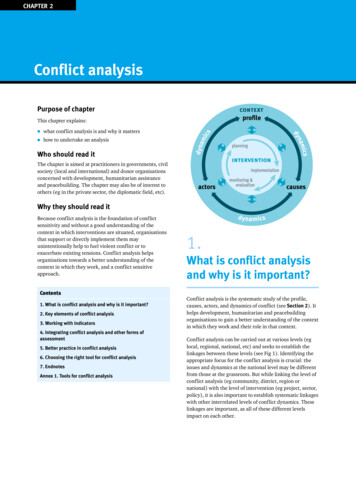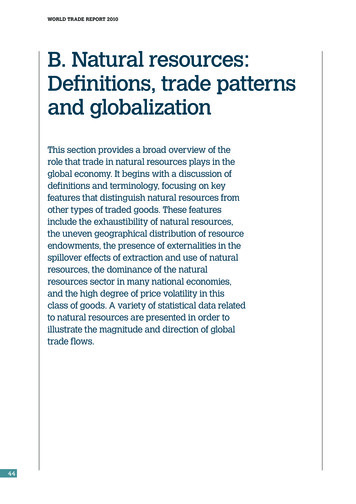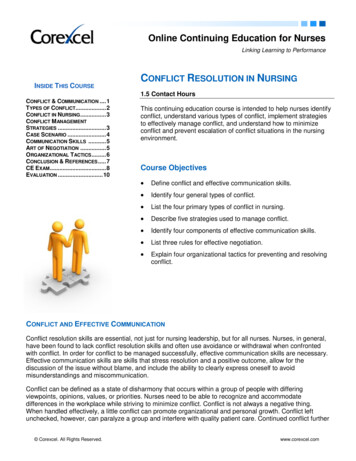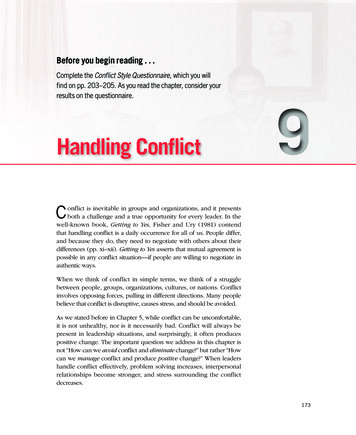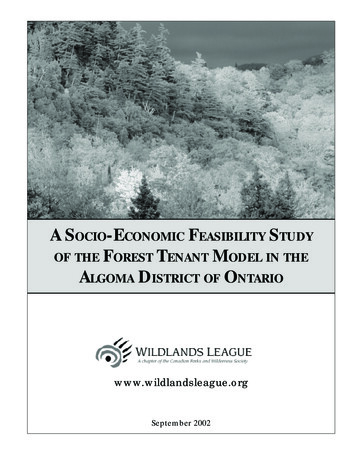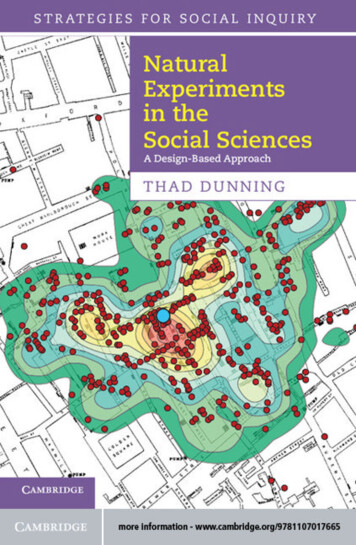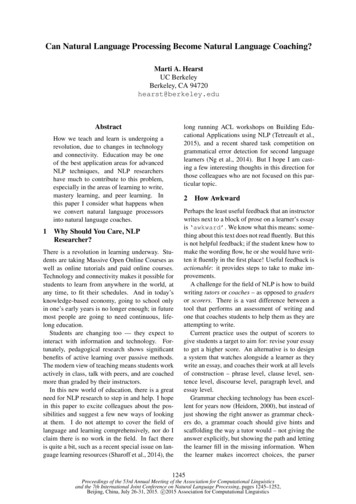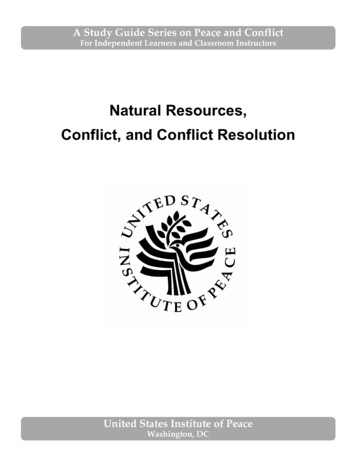
Transcription
A Study Guide Series on Peace and ConflictFor Independent Learners and Classroom InstructorsNatural Resources,Conflict, and Conflict ResolutionUnited States Institute of PeaceWashington, DC
ContentsPREFACE . 1About the Study Guide. 1Contact . 1About the United States Institute of Peace. 2COMPLEX RELATIONSHIP BETWEEN NATURAL RESOURCES AND VIOLENT CONFLICT . 3Introduction to Natural Resources and Conflict . 3Types of Natural Resources . 4The Role of Natural Resources in Society. 6The Stakeholders in Natural Resources . 7The Role of Natural Resources in Conflict . 8Managing or Resolving Conflicts . 10Conclusion . 12End Notes . 12GLOSSARY . 14FOR DISCUSSION AND INVESTIGATION. 17Discussion I: Value and Natural Resources . 17Discussion II: Equity and Natural Resources. 17Activity I: Concept Map . 17Activity II: Additional Research . 18Activity III: Simulation . 19RESOURCES . 27Articles and Chapters. 27Books . 28Online Reports and Other Documents . 29Online Classroom Resources . 30
PrefaceThe international system has witnessed dramatic changes in the recent past. Developments around theglobe and at home challenge us to rethink the role of the United States in the international community.What is our nation's place in this increasingly complex global picture? What can we do to nurture andpreserve international security and world peace?Our country depends on knowledgeable and thoughtful students and educators to build peace withfreedom and justice among nations and peoples. In the belief that the issues surrounding peace, justice,freedom, and security are vital to civic education, we developed this study guide to expand readers’knowledge, perspectives, and understanding about these complex topics.About the Study GuideThis study guide is designed to serve independent learners who want to find out more about internationalconflict and its resolution, as well as educators who want to introduce the topic to their students. Themain text discusses natural resources and related issues that play significant roles in managing conflictsand building international peace.Other features of the study guide include: A glossary of terms to help the reader build vocabulary used in the discussions about the topic. Discussion questions and activities to encourage critical thinking and active learning. A list of readings and multimedia resources for additional investigation and learningopportunities.While this study guide was developed as part of the National Peace Essay Contest, the topic’s importanceto the shape of international peace and security, now and in the future, is clearly worth additionalinvestigation and a deeper understanding. It is our hope that the general public will use the contents ofthe study guide to deepen their understanding of international peace and conflict.ContactUnited States Institute of PeaceEducation and Training Center: Domestic Programs1200 17th Street NW, Suite 200Washington, DC 20036www.usip.orgeducation@usip.orgFirst published September 14, 20071
About the United States Institute of PeaceThe United States Institute of Peace is an independent, nonpartisan, national institution established andfunded by Congress. Its goals are to help prevent and resolve violent conflicts, promote post-conflictstability and development, and increase peacebuilding capacity, tools, and intellectual capital worldwide.The Institute does this by empowering others with knowledge, skills, and resources, as well as by directlyengaging in peacebuilding efforts around the globe.Chairman of the Board: J. Robinson WestVice Chairman: María OteroPresident: Richard H. SolomonExecutive Vice President: Patricia Powers ThomsonVice President: Charles E. NelsonBoard of DirectorsJ. Robinson West (Chair), Chairman, PFC Energy, Washington, D.C.María Otero (Vice Chairman), President, ACCION International, Boston, Mass.Holly J. Burkhalter, Vice President, Government Affairs, International Justice Mission,Washington, D.C.Anne H. Cahn, Former Scholar in Residence, American University, Washington, D.C.Chester A. Crocker, James R. Schlesinger Professor of Strategic Studies, School of Foreign Service,Georgetown University, Washington, D.C.Laurie S. Fulton, Partner, Williams and Connolly, Washington, D.C.Charles Horner, Senior Fellow, Hudson Institute, Washington, D.C.Kathleen Martinez, Executive Director, World Institute on Disability, Oakland, CAGeorge E. Moose, Adjunct Professor of Practice, The George Washington University, Washington,D.C.Jeremy A. Rabkin, Professor of Law, George Mason University, Fairfax, Va.Ron Silver, Actor, Producer, Director, Primparous Productions, Inc., New York, NYJudy Van Rest, Executive Vice President, International Republican Institute, Washington, D.C.Members ex officioRobert M. Gates, Secretary of DefenseCondoleezza Rice, Secretary of StateRichard H. Solomon, President, United States Institute of Peace (nonvoting)Frances C. Wilson, Lieutenant General, U.S. Marine Corps; President, National Defense University2
Complex Relationship between Natural Resourcesand Violent ConflictNote to students who are planning to enter the National Peace Essay Contest:We have prepared this guide as an introduction to the issues surrounding natural resources andconflict. Please do not use this guide as a reference in your essay or as a bibliographic citation.We encourage you to consult the references listed in the resource section and in the endnotes.These resources may be included as references in the bibliography.Introduction to Natural Resources and ConflictFor most of us, conflict over natural resources is not a part of everyday life. We wake up in the morningand turn on the faucets to brush our teeth, shower, and drink a glass of water. We drive to and from work,school, and other activities, stopping every so often to fill up the tank with gas. We use energy to heat ourhomes, to cook food, to light our streets. Processed timber is used to form our desks, pencils, and paper.We sometimes buy diamond jewelry as a token of love or status.But in many areas around the world, access to natural resources cannot be taken for granted. According tothe United Nations, many women walk several hours a day just to find water; and more than two millionpeople, most of them children, die from diseases associated with water stresses each year.1 Some expertsare predicting that the world’s supply of oil will run out in the not too distant future. And almost half ofour old growth forests have been destroyed.The picture gets much more complicated when access to these natural resources become the reason for aconflict or, much more frequently, are used to fuel a conflict. Paul Collier, an expert on the economics ofcivil war, estimates that close to fifty armed conflicts active in 2001 had a strong link to natural resourceexploitation, in which either licit or illicit exploitation helped to trigger, intensify, or sustain violence. InPakistan and Bolivia, for example, violent protests have broken out over the distribution of water. In theMiddle East, disputes over oil fields in Kuwait, among other issues, led to the first Gulf War. In anotherexample, the rebel groups Revolutionary United Front (RUF) in Sierra Leone and National Union for theTotal Independence of Angola (known by its Portuguese acronym UNITA) used revenues derived fromdiamond mining to fund their rebellions against their respective governments. Research has also indicatedthat wars appear to be lasting longer: the expected duration of conflict is now more than double that ofconflicts that started prior to 1980.2 One possible explanation is that it is now much easier to sustain andfund conflict than it used to be.It may be helpful to think of natural resources in terms of how they are used. Some resources, such aswater and land, are used locally and may not have much impact beyond the local area. Other resources,such as timber, minerals, and oil, are used to produce revenue. It is these revenue-producing resourcesthat cause the most problems, sometimes called the resource curse—the paradox that countries withabundant natural resources often have less economic growth than those without natural resources. Thedependence on a few sources of revenue typically discourages diversification, leads to overheating of theeconomy, and increases volatility of prices and revenue. The abundance also often leads to governmentmismanagement and corruption.In these and other ways, competition over natural resources can lead to, intensify, or sustain violence. (Itshould be noted here that conflict over natural resources is often part of, and exacerbates, a larger struggleover political, economic, cultural, or religious issues in the society.) Less dramatic, and less well covered3
by the media, is the role natural resources can play in resolving and managing conflict and in preventingthe reoccurrence of violence in the post-conflict environment. To help students understand this role, thisstudy guide will briefly describe those natural resources that are typically involved in violent conflicts,the role of natural resources as causes of conflict or escalation of conflict, and their role in managingconflict and bringing about peace.Types of Natural ResourcesThe World Bank defines natural resources as “materials that occur in nature and are essential or useful tohumans, such as water, air, land, forests, fish and wildlife, topsoil, and minerals.”3 These resources can beclassified as renewable or nonrenewable. In most cases, renewable resources such as cropland, forests,and water can be replenished over time by natural processes and—if not overused—are indefinitelysustainable. Nonrenewable resources such as diamonds, minerals, and oil are found in finite quantities,and their value increases as supplies dwindle. A nation’s access to natural resources often determines itswealth and status in the world economic system.Below are some categories of natural resources. Agriculture, though strongly linked to natural resources,is generally not thought of as a natural resource as it depends largely on cultivation. However, economiesthat are heavily dependent on agriculture certainly depend heavily on other natural resources such aswater and land.This list is one of many ways to categorize natural resources. Because the concept of natural resources isbroad, the categorizations and definitions of natural resources can vary among disciplines. Otherexamples of categorization are: strategic raw materials, sources of energy, shared water resources, andfood; and biological resources, energy resources, food resources, land resources, mineral resources, soilresources, and water resources.Drinkable WaterWater is a necessity of life, and we use it for drinking, washing, agriculture, and industry. The UnitedNations World Water Assessment Programme estimates that every individual needs 20–50 liters (21-53quarts) of clean water every day.4 Since water covers nearly three fourths of the globe, we tend to think ofit as an abundant resource, but in fact drinkable water can be very scarce. Drought affects almost everycontinent and appears to be growing worse. The National Center for Atmospheric Research has found thatthe percentage of the earth’s land area stricken by serious drought has more than doubled since the1970s.5 In addition, water becomes scarce through pollution or restricted access. According to the UnitedNations, 1.1 billion people live without clean drinking water, and 3,900 children die every day fromwater-borne diseases. As the global population continues to rise—some predict a 40–50 percent increasewithin the next 50 years—water stress (when the demand for good quality water exceeds the supply) willbecome even more of a problem in the future.6 Water scarcity causes and sustains conflict in many partsof the globe; violent conflict over water resources has broken out in countries as diverse as China(Shandong and Guangdong Provinces 2000), Ethiopia (2006), India (2004), Kenya (2005), and Yemen(1999).7 In the Darfur region of Sudan, for example, much of the unrest is due to water shortages. Therecent discovery of an underground lake the size of Lake Erie may provide the resources to help end theconflict.8Jordan River DisputesIn the 1950s and 1960s, the animosity between Israel and its neighbors was heightened by disputes overthe headwaters of the Jordan River. Occasionally, the friction led to armed clashes, including Israeliattacks in 1965 and 1966 on Syrian construction sites that were part of a plan to divert water fromJordan River tributaries. These disputes helped create the pretexts and climate for the regional war in1967.4
Bodies of WaterBodies of water such as oceans, seas, lakes, and rivers can also be linked to conflict due to their roles intransportation, development, and culture. A population’s dependence on sources of income within bodiesof water, such as fisheries and offshore oil fields, can lead to conflict. In addition, neither fish nor waterfollow country borders, and both must often be shared among countries. Disputes over fishing led to the“cod wars” between Britain and Iceland in the 1950s and 1970s (no one was injured but shots were firedand several ships were rammed), while natural resources lie at the heart of the contested claims in theSouth China Sea. More than 260 river basins, for example, are shared by two or more countries mostlywithout adequate legal arrangements.9 In fact, however, most conflicts over water are resolved peacefully,perhaps because water is so important. There are more than 3,800 declarations or conventions on water.That so large a number of agreements exist for water clearly shows the potential for negotiatedsettlements in disputes over natural resources rather than violent conflict.10LandBecause of population growth and environmental degradation, land that can be used for personal,industrial, or agricultural purposes is becoming increasingly scarce. Of course, possession of land meansaccess to many other resources, such as minerals, timber, and animals, and land therefore often holds ahigh economic value. In addition, communities often have strong emotional and symbolic attachments toland and the resources on it. It is easy to see why competition for control of valuable land, includingissues of government authority and regulation, can cause or sustain conflict. Traditionally, most warshave been fought over control of land (along with other issues); for example, Ecuador and Peru havefought several wars over their disputed border. More recently, violent conflict over land has occurred inChina, East Timor, Kosovo, Rwanda, and Tajikistan, to name only a few examples.TimberTimber functions primarily as a source of income. As is the case with water, timber is an increasinglyscarce resource. Although forests cover 30 percent of the world’s land area, 46 percent of the old growthforests have already been destroyed.11 Population growth and industrialization are destroying rainforestsand causing environmental degradation. As a commodity that is easily accessible, easy to transport,versatile, lucrative, and necessary for reconstruction and development, timber can play an important rolein all stages of peace and conflict. Examples of conflict over timber can be found in Burma, Cambodia,the Democratic Republic of Congo, and Liberia. On the other hand, there are also examples of benefitsharing plans in Indonesia and community forest management enterprises in Latin America.12Oil and GasThe two primary sources of fuel are oil (petroleum)—a flammable liquid that can be refined intogasoline—and natural gas, a combustible gas used for fuel and lighting. Fuel scarcity, or at least access tofuel, is one of the greatest concerns for developing and developed countries, given their dependence onenergy sources. With a greater global rate of industrialization, many countries have invested in and paidparticular attention to alternative types of energy such as nuclear, electrical, wind, and solar energy. Still,the U.S. Department of Energy estimates that by 2020, two thirds of the world’s known petroleumreserves will be consumed.13 Many mainstream media sources and other organizations warn that easilyaccessible oil, especially in Saudi Arabia, is rapidly disappearing and that the world will soon face the endof the oil era.14 Moreover, many of the world’s largest petroleum reserves are located in areas sufferingfrom political instability or conflict, such as Iran, Iraq, Nigeria, Venezuela, and Sudan. Thus the value anddemand for fuel, especially petroleum, allows conflicts in these areas to have an impact on the globaleconomy. On the other hand, the developed world’s increasing demand for oil, and its search for “supplysecurity,” can exacerbate existing conflicts.As with rivers, oil fields and pipelines frequently cross borders, which often contributes to tensions but5
also puts a premium on cross-border cooperation. After East Timor separated from Indonesia in 2002, forexample, it renegotiated the agreement Indonesia had made with Australia over oil and gas rights indisputed areas of the Timor Sea. And several nations are involved in ongoing negotiations with variousparties to build pipelines in the Caspian Sea region, including Azerbaijan, Georgia, Kazakhstan, andRussia.There are a number of new approaches to facilitate the best use of oil revenues, such as those supportedby the International Monetary Fund (IMF), which seeks to improve governance in resource-rich countriessuch as Nigeria, Azerbaijan, and Gabon and reduce the potential for fighting over access to revenues.15Even with international encouragement, however, it has been enormously difficult for the Iraqis tonegotiate equitable arrangements for sharing oil and gas revenues among the regions after the fall ofSaddam Hussein.MineralsMinerals are naturally occurring substances obtained usually from the ground. According to the UnitedStates Agency for International Development (USAID), “valuable minerals become conflict mineralswhen their control, exploitation, trade, taxation or protection contributes to, or benefits from, armedconflict.”16 Conflict minerals have varied commodity values and occur in many geographical locations:for example, diamonds in Western Africa, amber in Russia, and gold in Indonesia. While minerals such asgold and diamonds hold significant value as gems, all minerals generate revenue and power forgovernments, rebel groups, or whoever owns the land or has the ability legally or illegally to extract them.Furthermore, conflicts over minerals do not necessarily stay within boundaries; neighboring countriessometimes compete for resource wealth and thus exacerbate conflict or prevent peacebuilding.Diamonds are the conflict minerals that have received the most attention. They have been used by severalrebel groups in Africa as a source of income, including groups in Angola and Sierra Leone.17 They areeasy to steal and easy to move to market and difficult to trace. Protests by non-governmentalorganizations (NGOs) and other concerned groups in the 1990s about the brutal human rights violationsconnected to the conflict diamond trade led to efforts by the international community to develop acertification system that has helped curb their presence in the international market. There have also beenproposals to develop a “fingerprinting” system that would define chemical impurities unique to eachmining site; a national database would track each consignment of minerals.Other examples of conflict minerals include coltan (tantalite, used in cell phones, computers, and gameconsoles) in the Democratic Republic of Congo and copper in Papua New Guinea.The Role of Natural Resources in SocietyNatural resources are an integral part of society, as sources of income, industry, and identity. Developingcountries tend to be more dependent on natural resources as their primary source of income, and manyindividuals depend on these resources for their livelihoods. It is estimated that half of the world’spopulation remains directly tied to local natural resources; many rural communities depend uponagriculture, fisheries, minerals, and timber as their main sources of income.18 A developing country’sability to modernize economically is often dependent on access to natural resources. Water is essential forboth successful agriculture and manufacturing; for example, the lack of clean water for the labor force candrastically inhibit a country’s economic growth.Some natural resources play a central role in the well-being of the local community and some are used fortrade purposes. Natural resources, both renewable and nonrenewable, that are controlled by the state(which is the case in most developing countries) are used as exports by the government to attain profit and6
power. Developed countries have established an industrial infrastructure that relies heavily on imports ofnatural resources, and mineral-rich countries are positioned to supply that demand. Many of theseresources have great value in the global market, which allows the developing countries in possession ofthe resources to be active participants in the international economic system. Perhaps the best example ofdeveloping countries organizing to control their own fate is the Organization of Petroleum ExportingCountries (OPEC), which works to protect the interests of oil-producing countries while maintainingstable oil prices and reducing the potential for conflict.Not only do natural resources serve as a commodity in the local or global economic structure but they alsoplay a prominent cultural role for many local communities and may even be a point of pride for the nationas a whole, a part of the country’s patrimony (one of the reasons many developing nations want to controltheir natural resources). Resources such as land, water, and timber (forests) usually have historical andcultural significance, serving as the home of ancient civilizations, historical artifacts, and culturalpractices. These resources are part of the identity of a community or people. People hold a powerful senseof attachment to resources in which they have invested labor and sweat, in some cases for generations.Many people in Southeast Asia fish as a means of income, for example, and they have developedelaborate cultural and religious traditions that accompany their work.Ancestral Domain in the PhilippinesA significant principle at stake in the armed clashes in the Philippines between the indigenous Moropopulation in Mindanao and the government is the issue of ancestral domain. The Moros claim thatcontrol over the environment and the region’s natural resources is rightfully and legally theirs because ofhistoric rights, legal titles, customary law, and cultural bonds. Ancestral domain has been the basis fortheir demands (at times violent) for self-rule.The Stakeholders in Natural ResourcesThere are many groups whose interests in and actions concerning a region’s natural resources can lead toor exacerbate conflict. These stakeholders may include local communities, governments, rebel groups,and outside actors.As discussed previously, natural resources are deeply tied to local communities through income, culture,and identity and thus often hold more than purely economic value for individuals and communities.Governments provide oversight for resource management, regulate trade and development, establishlicensing protocols, levy taxes on resource industries, and engage in natural resource extraction directly orby selling extraction rights. Governments that receive substantial income from natural resources may haveless incentive to enter into power-sharing arrangements or promote democracy-building efforts becausethey have the means to buy off or intimidate their opponents. In those cases in which there is littlegovernment accountability or financial transparency, government officials are more likely to take bribes,funnel public funds to private accounts, and ignore environmental degradation, resource-related violence,and human rights violations. Often in developing countries with weak state institutions, powerful groupsare able to use persuasion or force to gain improper access to natural resources and their profits.Rebel groups have used natural resources as a commodity to fund weapon purchases and mobilizefighters. Using violent means to capture resource-rich territories and forced labor to extract naturalresources, rebel groups have set up lucrative businesses that profit from participation in the global market,one notable example being the drug trade. Paul Collier argues that rebel groups in some developing7
countries have found ripe conditions to make rebellion financially and militarily viable.19Among the most important actors in post-conflict stages are those outside parties who can influencenatural resource management: powerful governments of either resource-rich or economically richcountries; international financial institutions and other international organizations; business, industry, andother users of resources; and NGOs. Often in post-conflict situations, parties are reluctant to stop fighting,let alone work together to rebuild the country. Each side has its own interests—be it ethnic identity,wealth, impunity, or power—and often will continue to exploit natural resources in order to maintaineconomic or political advantages. In developing countries where international standards have been nonexistent prior to conflict, it is often difficult to manage natural resources with transparency, equity, andsustainability. Outside organizations can help to establish such standards that can curb corruption, buildtrust, and prevent competing groups from fighting over natural resource wealth.For instance, international organizations—such as the United Nations, the World Bank Group, and theInternational Monetary Fund—can track economic stability and health conditions and provide aid interms of oversight and debt management. Likewise, local and international businesses and industries thatparticipate in the selling and processing of resources play a role in determining the standards andregulations by which extraction and trade occur. Efforts by the international community are not alwayseffective, however. For example, when the UN Security Council sought to end the export of logs fromKhmer Rouge–controlled areas of Cambodia in the early 1990s in response to human rights violations bythe Khmer Rouge, the ban was, by most accounts, largely ignored. In one unintended side effect, sawmillsproliferated in the border region, so that logs could be sawed into boards, which were not banned.20 Insome instances, outside interest in natural resource exploitation can fuel the conflict by providing funds tothe warring parties.Finally, NGOs, both domestic and international, play varied roles by publicizing conflicts as well aslobbying governments and other actors to improve human rights, transparency, and the fight againstcorruption. Transparency International, for example, publishes an annual corruption index and providespractical advice on ho
The United States Institute of Peace is an independent, nonpartisan, national institution established and funded by Congress. Its goals are to help prevent and resolve violent conflicts, promote post-conflict stability and development, and increase peacebuilding capacity, tools, and intellectual capital worldwide.
